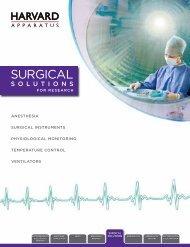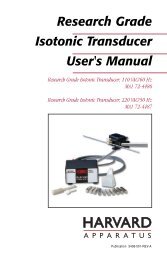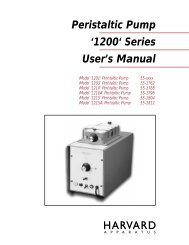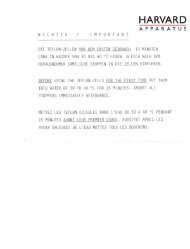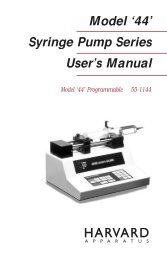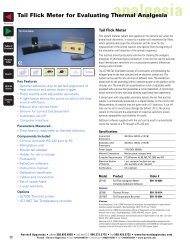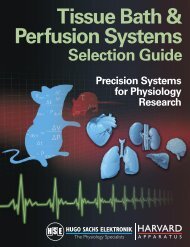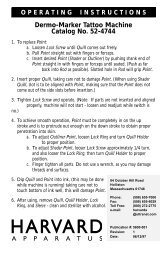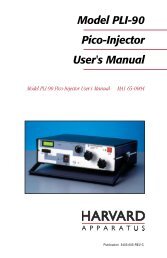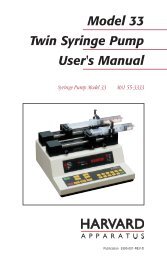to download the new 2011 Syringe Pump Catalog - Harvard ...
to download the new 2011 Syringe Pump Catalog - Harvard ...
to download the new 2011 Syringe Pump Catalog - Harvard ...
Create successful ePaper yourself
Turn your PDF publications into a flip-book with our unique Google optimized e-Paper software.
<strong>Syringe</strong> <strong>Pump</strong> Pressure and Flow Rate<br />
How <strong>to</strong> Calculate <strong>the</strong> Pressure of Various <strong>Syringe</strong> Sizes<br />
The pressure that a syringe pump can generate is a function of both<br />
<strong>the</strong> force of <strong>the</strong> pump (measured at <strong>the</strong> pusher block in pounds) as<br />
well as <strong>the</strong> physical characteristics of <strong>the</strong> syringe and setup used. The<br />
following table compares various syringe pumps and <strong>the</strong> pressures in<br />
PSI (pounds per square inch). Each data point was calculated by<br />
dividing <strong>the</strong> average pump force by <strong>the</strong> surface area (in square inches)<br />
of syringes with diameters from 0.1 <strong>to</strong> 50 mm. Diameters and surface<br />
areas for a variety of syringes can be found in <strong>the</strong> table on page 107.<br />
This table is intended <strong>to</strong> be a guide of <strong>to</strong>tal pressures generated.<br />
Actual values may be higher or lower than <strong>the</strong> listed pressures due <strong>to</strong><br />
<strong>the</strong> influence of o<strong>the</strong>r fac<strong>to</strong>rs such as tubing diameter and length.<br />
When using more than one syringe sharing <strong>the</strong> same pusher block, <strong>the</strong><br />
pressure is calculated by dividing <strong>the</strong> force (lbs) by <strong>the</strong> <strong>to</strong>tal surface<br />
area (square inches) of all syringes on <strong>the</strong> pump. For example, nominal<br />
pressure obtained using two 25 ml Hamil<strong>to</strong>n Gastight ® syringes on a<br />
PHD 22/2000 standard pressure syringe pump would be: 50 lbs /<br />
(0.644 in2 X 2) = 38.81 PSI (2.68 bars).<br />
<strong>Pump</strong> Average Pressure A (PSI) B<br />
<strong>Syringe</strong> Size <strong>Syringe</strong> Dia (mm) <strong>Pump</strong> 11 Plus <strong>Pump</strong> 22 <strong>Pump</strong> 33 PHD 22/2000 PHD 22/2000 Hpsi PHD 4400 Hpsi<br />
0.5 µl 0.1 >1000 >1000 >1000 >1000 – >1000<br />
10 µl 0.5 >1000 >1000 >1000 >1000 – >1000<br />
50 µl 1 >1000 >1000 >1000 >1000 – >1000<br />
1 ml 5 526 >1000 >1000 >1000 – >1000<br />
5 ml 10 131 386 468 394 – 1438<br />
10 ml 15 58 172 208 175 – 639<br />
50 ml 25 21 62 75 63 569 230<br />
Force (lbs) 16 47 57 48 433 200<br />
See page 25 26 27 29 31 31<br />
A. Calculated pressure based on pump force at average speed<br />
– Higher pressures may be achieved at minimum speed and lower pressures at maximum speed.<br />
– <strong>Pump</strong> speed and force are inversely proportional.<br />
– Most syringes are pressure rated and may not be able <strong>to</strong> <strong>to</strong>lerate pressure generated by <strong>the</strong> syringe pump. Consult <strong>Harvard</strong> Apparatus or your syringe<br />
manufacturer for syringe details and specifications.<br />
B. To convert pressure from PSI <strong>to</strong> bars use <strong>the</strong> following equation: bar pressure = PSI x 0.0690.<br />
C. Actual force is higher. Use of pump with greater back pressure may result in premature wear of syringe pump halfnut.<br />
Minimum/Maximum Flow Rates<br />
by <strong>Pump</strong> and <strong>Syringe</strong> Size<br />
Flow rates were calculated based on <strong>the</strong> pusher block travel rate for<br />
each pump (rate at which <strong>the</strong> syringe pump moves <strong>the</strong> syringe<br />
plunger) and <strong>the</strong> diameter of <strong>the</strong> syringe.<br />
PHD 22/2000 Hpsi Flow Rates<br />
<strong>Syringe</strong> Size Nominal Diameter Minimum µl/hr Maximum ml/min<br />
20 ml 19.13 mm 1.5 20<br />
50 ml 28.60 mm 3.4 46<br />
100 ml 34.90 mm 5.0 68<br />
200 ml 44.75 mm 8.2 112<br />
* The Rates listed are for single stainless steel syringe<br />
**Note: These figures have been rounded and <strong>the</strong>refore may not exactly match<br />
<strong>the</strong> <strong>Syringe</strong> Diameter Chart on page 107.<br />
PHD ULTRA Hpsi Flow Rates<br />
<strong>Syringe</strong> Size Nominal Diameter Minimum nl/min Maximum ml/min<br />
20 ml 19.13 mm 50.699 26.324<br />
50 ml 28.60 mm 113.317 58.837<br />
100 ml 34.90 mm 168.738 87.613<br />
200 ml 44.75 mm 277.489 144.08<br />
* The Rates listed are for single stainless steel syringe<br />
**Note: These figures have been rounded and <strong>the</strong>refore may not exactly match<br />
<strong>the</strong> <strong>Syringe</strong> Diameter Chart on page 107.<br />
<strong>Harvard</strong> Apparatus phone 508.893.8999 <strong>to</strong>ll free U.S. 800.272.2775 fax 508.429.5732 www.harvardapparatus.com 103




